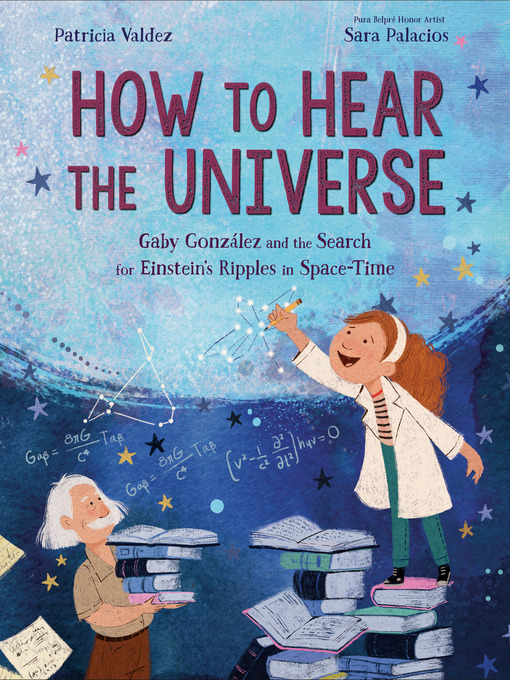- No wait, no problems
- Picture Books
- Who Was?
- Garfield
- What's new?
- Popular titles
- Check these out!
- See all ebooks collections
How to Hear the Universe
Gaby González and the Search for Einstein's Ripples in Space-Time
In 1916, Albert Einstein had a theory. He thought that somewhere out in the universe, there were collisions in space. These collisions could cause little sound waves in the fabric of space-time that might carry many secrets of the distant universe. But it was only a theory. He could not prove it in his lifetime.
Many years later, an immigrant scientist named Gabriela Gonzalez asked the same questions. Armed with modern technology, she joined a team of physicists who set out to prove Einstein's theory. At first, there was nothing. But then... they heard a sound. Gabriela and her team examined, and measured, and re-measured until they were sure.
Completing the work that Albert Einstein had begun 100 years earlier, Gonzalez broke ground for new space-time research. In a fascinating picture book that covers 100 years, 2 pioneering scientists, and 1 trailblazing discovery, Patricia Valdez sheds light on a little known but extraordinary story.
-
Creators
-
Publisher
-
Release date
March 8, 2022 -
Formats
-
Kindle Book
-
OverDrive Read
- ISBN: 9781984894618
-
-
Languages
- English
-
Levels
- Lexile® Measure: 1020
- Text Difficulty: 6-8
-
Reviews
-
Booklist
February 1, 2022
Grades K-3 The story begins in Berlin with Einstein carrying out some of the imaginative thought experiments that led to his groundbreaking work, including a reference to the collision of large space objects causing ripples in space-time, ripples that in his opinion, we would not be able to detect. Shifting forward 50 years, an Argentinian girl named Gabriela (Gaby) Gonz�lez wonders about the night sky. She grows up, studies physics, and moves to the U.S., where she eventually leads a team of physicists finding ways to eliminate background noise for two complex machines built to listen for ripples within space-time. A century after Einstein's Theory of General Relativity, the project succeeded in detecting ripples in space-time caused by two black holes colliding. Given the audience, the book's text concentrates more on Einstein's creative scenarios than on his physics, but even more, it tells the story of a Latina physicist whose team made a significant contribution. The upbeat illustrations, digitally enhanced watercolors, set a jaunty tone, and appended notes provide additional information. An ambitious picture book.COPYRIGHT(2022) Booklist, ALL RIGHTS RESERVED.
-
Publisher's Weekly
May 9, 2022
Physicist Gabriela “Gaby” González (b. 1965) stars in this polished STEM biography that opens 100 years ago with a skillfully rendered, approachable description of Albert Einstein’s theory that space-time could ripple. The problem: “Without a way to hear ripples in space-time, people considered Einstein’s idea simply a fairy tale.” Fast forward 50 years to Argentina, where young González develops a passion for physics. In lively prose, Valdez describes how González moves to the U.S. and spends “long days and long nights thinking, testing, and measuring,” trying to encounter Einstein’s ripples, until eventually, she and a team—portrayed with varying abilities and skin tones—successfully perceive the collision of two black holes. Palacios’s digital and watercolor art bursts with science tropes, including equations, stars, and white lab coats, supporting the book’s broader, empowering embrace of science as transcending space and time. Ample back matter includes an author’s note alongside further resources. Ages 4–8. -
School Library Journal
Starred review from April 29, 2022
Gr 1-4-Albert Einstein published his theory of general relativity in Germany in 1915, but he could not detect or measure the ripples (gravitational waves) in space-time that he theorized existed. Years later, in Argentina, a young girl named Gabriela (Gaby) Gonz�lez became curious about time, space, and gravity; she went on to study physics, and became part of the team that eventually was able to measure the gravitational waves Einstein had described. This advanced subject matter is presented with clarity and a sense of wonder, making it accessible to a young (often space-obsessed) audience, with additional back matter (time line, glossary, sources, notes) for those who want more detail. Palacios's illustrations feature recurring motifs of dragonflies, frogs on lily pads, speech bubbles filled with pictures and diagrams, chalkboards full of equations, and five-pointed stars. VERDICT This STEM title is an excellent addition to any public or school library; Gaby Gonz�lez deserves the same recognition as Margaret Mitchell, Katherine Johnson, Grace Hopper, Ada Lovelace, and Mario Molina.-Jenny Arch
Copyright 2022 School Library Journal, LLC Used with permission.
-
Languages
- English
Levels
- Lexile® Measure:1020
- Text Difficulty:6-8
Loading
Why is availability limited?
×Availability can change throughout the month based on the library's budget. You can still place a hold on the title, and your hold will be automatically filled as soon as the title is available again.
The Kindle Book format for this title is not supported on:
×- - Kindle 1
- - Kindle 2
- - Kindle DX
- - Kindle Keyboard
- - Kindle 4
- - Kindle Touch
- - Kindle 5
- - Kindle Paperwhite
- - Kindle 7
- - Kindle Voyage
Read-along ebook
×The OverDrive Read format of this ebook has professional narration that plays while you read in your browser. Learn more here.



